History
The construction of the town walls by William de Valence, 1st Earl of Pembroke, probably began after the outer ward of Pembroke Castle was completed about 1280 as they tie into the castle's wall. They probably replaced a timber palisade and/or earthen rampart that protected the town, most likely at the narrowest point of the peninsula upon which the town is built. Construction was likely continued by his son Aymer (1296–1324), but the walls may not have been completed as there is a 1377 commission that the constable of the castle was charged to 'survey, repair, and fortify the castle and town of Pembroke'. [1]
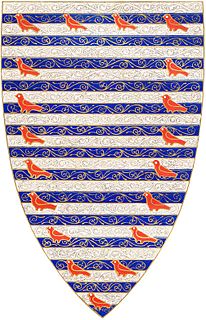
William de Valence, born Guillaume de Lusignan, was a French nobleman and knight who became important in English politics due to his relationship to King Henry III of England. He was heavily involved in the Second Barons' War, supporting the King and Prince Edward against the rebels led by Simon de Montfort. He took the name de Valence after his birthplace, Valence, near Lusignan.

Pembroke Castle is a medieval castle in Pembroke, Pembrokeshire, Wales. The castle was the original family seat of the Earldom of Pembroke. A Grade I listed building since 1951, it underwent major restoration during the early 20th century.

A palisade—sometimes called a stakewall or a paling—is typically a fence or wall made from iron or wooden stakes, or tree trunks and used as a defensive structure or enclosure.
A century later, money was allocated for 'making a stone wall on the south side of the town of Pembroke' in 1479–80, but this may be interpreted as a repair or rebuild of the existing wall, completion of a missing section of wall or the strengthening of the wall, as was done with the Tenby town walls at about the same time by Jasper Tudor, Duke of Bedford. [2]

The Tenby town walls are Grade I-listed medieval defensive structures around the town of Tenby in Pembrokeshire. They are assessed as one of the most important surviving medieval city walls in Britain. The walls were built in the 13th century by the Earls of Pembroke and improved in the 1450s. They were last known to have been repaired in 1588 and have declined thereafter. Most of the town's gates were demolished beginning in the 18th century and only one survives.

Pembroke Dock is a town and a community in Pembrokeshire, South West Wales, 3 miles (4.8 km) northwest of Pembroke on the banks of the River Cleddau. Originally Paterchurch, a small fishing village, Pembroke Dock town expanded rapidly following the construction of the Royal Navy Dockyard in 1814. The Cleddau Bridge links Pembroke Dock with Neyland.

Manorbier is a village, community and parish on the south coast of Pembrokeshire, Wales. An electoral ward with the same name exists. This ward stretches inland to St Florence and had a total population at the 2011 Census of 2,083.. Manorbier is twinned with Vernou-la-Celle-sur-Seine, France.

Manorbier Castle is a Norman castle located in the village of Manorbier, five miles south-west of Tenby, West Wales. The castle was part of a mesne lorship under the control of the medieval Earls of Pembroke. It was founded in the late 11th century by the Anglo-Norman de Barry family.
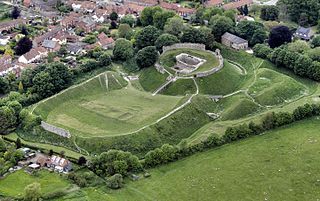
Castle Acre Castle and town walls are a set of ruined medieval defences built in the village of Castle Acre, Norfolk. The castle was built soon after the Norman Conquest by William de Warenne, the Earl of Surrey, at the intersection of the River Nar and the Peddars Way. William constructed a motte-and-bailey castle during the 1070s, protected by large earthwork ramparts, with a large country house in the centre of the motte. Soon after, a small community of Cluniac monks were given the castle's chapel in the outer bailey; under William, the second earl, the order was given land and estates to establish Castle Acre Priory alongside the castle. A deer park was created nearby for hunting.

Pevensey Castle is a medieval castle and former Roman Saxon Shore fort at Pevensey in the English county of East Sussex. The site is a Scheduled Monument in the care of English Heritage and is open to visitors. Built around 290 AD and known to the Romans as Anderitum, the fort appears to have been the base for a fleet called the Classis Anderidaensis. The reasons for its construction are unclear; long thought to have been part of a Roman defensive system to guard the British and Gallic coasts against Saxon pirates, it has more recently been suggested that Anderitum and the other Saxon Shore forts were built by a usurper in an ultimately unsuccessful attempt to prevent Rome from reimposing its control over Britain.
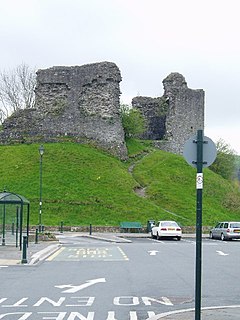
Llandovery Castle is a late thirteenth-century, Grade II*-listed, castle ruin in the town of Llandovery in Carmarthenshire, Wales. It occupies a knoll overlooking the River Towy and the land surrounding it. The Normans built a castle in the current location in the early twelfth century and this was rebuilt in stone. It was burnt in the early sixteenth century and never repaired.

Haverfordwest Castle is a castle located in the town centre at Haverfordwest, Pembrokeshire, south Wales, located in a naturally defensive position at the end of a strong, isolated ridge. The castle was established during Norman times in 1120 but much of the architecture remaining today is dated to 1290. For centuries the castle was an English stronghold.
There are several other notable castles in area; Wiston Castle lies 6 miles (9.7 km) to the northeast and Pembroke Castle lies 12 miles (19 km) to the south.

Brougham Castle is a medieval building about 2 miles (3.2 km) south-east of Penrith, Cumbria, England. The castle was founded by Robert I de Vieuxpont in the early 13th century. The site, near the confluence of the rivers, Eamont and Lowther, had been chosen by the Romans for a Roman fort called Brocavum. The castle is scheduled as an Ancient Monument, along with the fort, as "Brougham Roman fort and Brougham Castle".
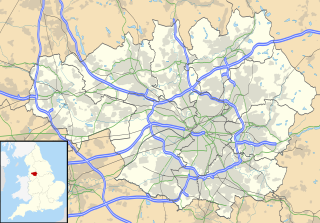
Buckton Castle was a medieval enclosure castle near Carrbrook in Stalybridge, Greater Manchester, England. It was surrounded by a 2.8-metre-wide (9 ft) stone curtain wall and a ditch 10 metres (33 ft) wide by 6 metres (20 ft) deep. Buckton is one of the earliest stone castles in North West England and only survives as buried remains overgrown with heather and peat. It was most likely built and demolished in the 12th century. The earliest surviving record of the site dates from 1360, by which time it was lying derelict. The few finds retrieved during archaeological investigations indicate that Buckton Castle may not have been completed.

St Florence is a village, parish and community situated 4 miles (6 km) to the west of the seaside town of Tenby in Pembrokeshire, Wales. It had a population of 490, 650 751(Parish Headcount) in 2001. The present name of the village is taken from the saint to whom the church is dedicated, St. Florentius.
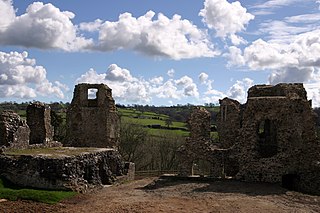
Narberth Castle is a ruined Norman fortress in the town of Narberth, Pembrokeshire, West Wales. It forms part of the Landsker Line.
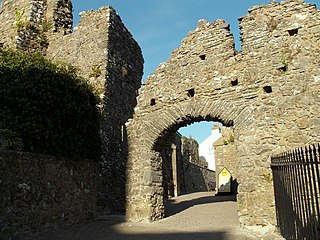
Tenby Castle was a fortification standing on a headland separated by an isthmus from the town of Tenby, Pembrokeshire, Wales. The remaining stone structure dates from the 13th century but there are mentions of the castle from as early as 1153. It is a Grade II* listed building.

Peveril Castle is a ruined 11th-century castle overlooking the village of Castleton in the English county of Derbyshire. It was the main settlement of the feudal barony of William Peverel, known as the Honour of Peverel, and was founded some time between the Norman Conquest of 1066 and its first recorded mention in the Domesday Survey of 1086, by Peverel, who held lands in Nottinghamshire and Derbyshire as a tenant-in-chief of the king. The town became the economic centre of the barony. The castle has views across the Hope Valley and Cave Dale.

Tenby Museum and Art Gallery, located in Tenby, Pembrokeshire, South West Wales, is the oldest independent museum in Wales. Established in 1878 the Museum has a collection of local geology, biology, archaeological and maritime artifacts. Accompanying the regular exhibitions since 1976 is a collection of images and crafts by local and national artists such as Augustus and Gwen John.
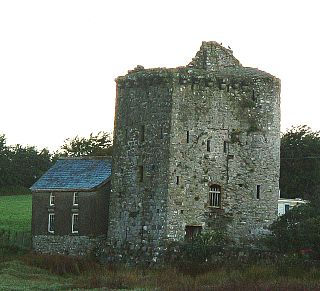
The Pele Tower in Angle, Pembrokeshire, in southwest Wales is a Grade I-listed stone fortified tower dating back to the 14th century and is the only remaining example of a pele tower in Wales.

Amroth Castle is a Grade I listed building in Pembrokeshire, Wales. It is a castellated country house dating mainly from the 18th century built on an earlier, probably 15th century, residence, and is now a holiday venue.
























